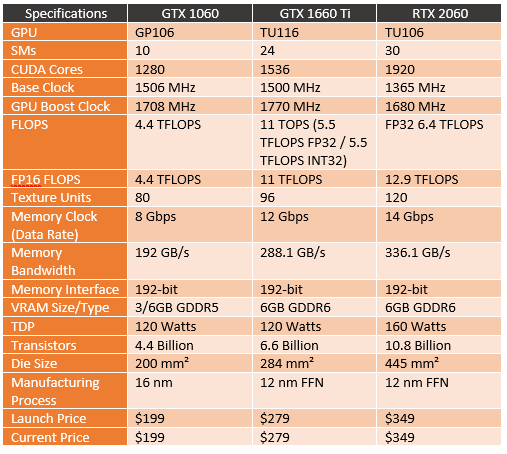Nvidia has been slowly refreshing their product stack for about six months now as they have been introducing their new RTX 2000 series of cards. Well, we are finally getting down into the sweet spot and today they are introducing the replacement to the always popular GTX 1060. But what may come as a surprise to some of you is that replacement isn’t going to be an RTX card. Nvidia’s new card is still Turning based, but with this launch, they have dropped the Tensor and RT cores that make an RTX card so this launch is a GTX card. Today they are launching the GTX 1660 Ti. I’m not going to pretend to understand the reasoning for the move away from the 2000 series numbering, but today I’m going to dive into what is different with the GTX 1660 Ti and then check out the MSI GTX 1660 Ti Ventus XS and see how it performs.
Product Name: MSI GTX 1660 Ti Ventus XS
Review Sample Provided by: MSI
Written by: Wes Compton
Pictures by: Wes Compton
Amazon Affiliate Link: HERE
GTX 1660 Ti WUT?
I’m sure a few of you are sitting here saying WTF is a GTX 1660 Ti, why isn’t it an RTX card. So many questions!! Well, I kind of touched on it in the opening, but the reason for going back to the GTX from RTX is because Nvidia didn’t include what makes an RTX card and RTX card on this one. That would be the ray tracing cores and the Tensor cores used for AI. Don’t panic though, this isn’t a rebranded design like sometimes happens. The GTX 1660 Ti is still based on the Turing architecture, they just made a few tweaks. Dropping the RTX and Tensor cores was inevitable, you can tell just by looking at the die sizes of all of the RTX cards. I spoke about it a lot in my early RTX reviews, but huge die sizes to support a full traditional GPU as well as Tensor and RT cores makes for a huge die and large die sizes cost a lot of money. Not only that, but the ray tracing capabilities as Nvidia dropped down to cards like the RTX 2060 get lower and at some point, there is no point in including them if turning ray tracing on will make the game unplayable.
The real question though is what features that were introduced with Turning are staying with this new GPU because that is what will set this apart from the Pascal-based GPUs. A big one is the new unified cache architecture. This is big in accelerating shader processing. Turing combines two SMs cache together while also increasing the overall L1 cache size.
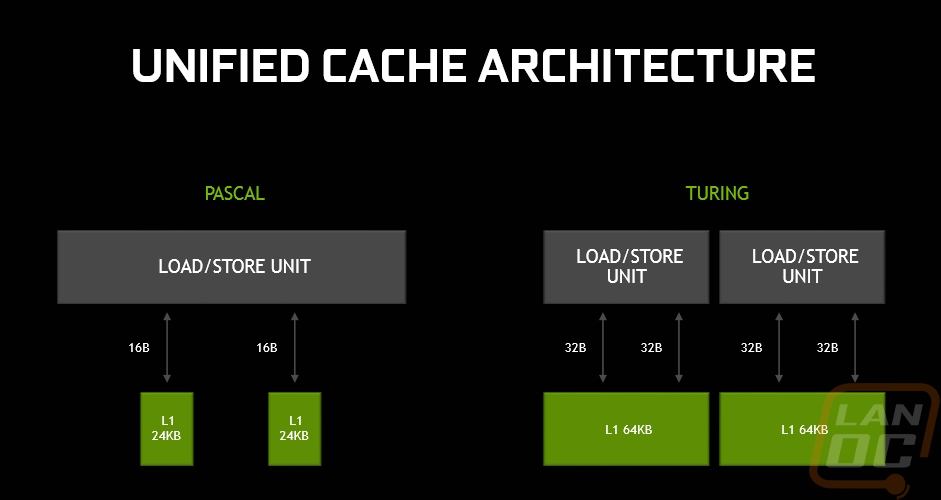 Turning also changes concurrent float and integer in FP32 and INT32. Basically with Pascal things would stall when an INT is calculated but now they can run concurrently. They can run different data paths at the same time significantly speeding things up. In the example that Nvidia provides you can see that with the GTX 1060 something that would take 100 instructions can now be done in 62 because it can run both at the same time, not one at a time.
Turning also changes concurrent float and integer in FP32 and INT32. Basically with Pascal things would stall when an INT is calculated but now they can run concurrently. They can run different data paths at the same time significantly speeding things up. In the example that Nvidia provides you can see that with the GTX 1060 something that would take 100 instructions can now be done in 62 because it can run both at the same time, not one at a time.
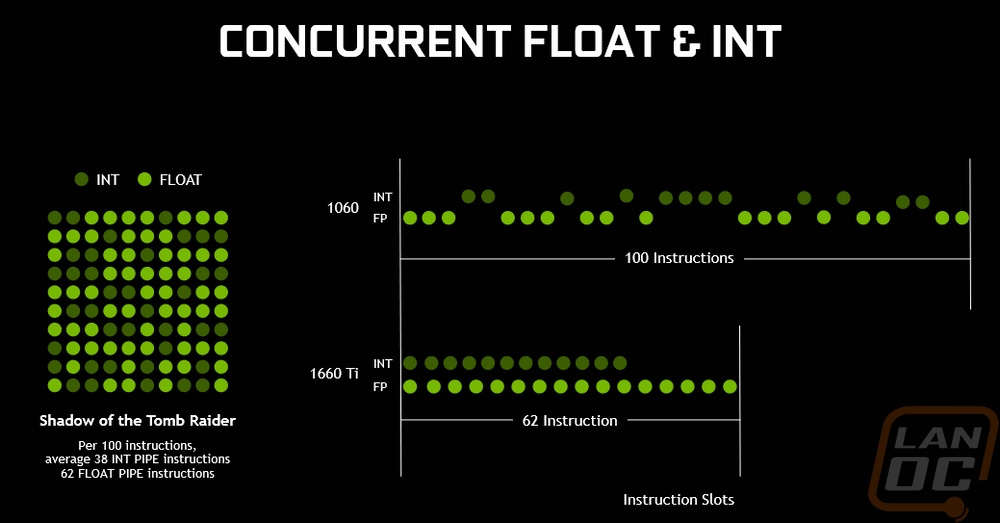 Nvidia spent a lot of time comparing the GTX 1660 Ti with the GTX 1060 because that is what they are replacing and on paper at least it does look like a good bump in performance. There are now twice as many TOPs and FP16 FLOPs and three times as much L1 Cache. Adding independent INT32 calculations is great and you can see that with the 5.5 TOPS in it, but its also important to note that even if everything was still running on the FP32’s that alone has seen a bump up from 4.4 to 5.5 TFLOPs aka teraflops with FLOPs being floating point operations per second. That is a crazy amount of processing in one second, it takes me all afternoon to get around to putting the dishes in the dishwasher! For reference (on the card FLOPS not my extreme laziness) the GTX 980 did 5 TFLOPs and the GTX 780 did 4 TFLOPs. A lot of people who get on board with the upgrade every two generations might be coming from the GTX 960 would be moving from 2.4 TFLOPs.
Nvidia spent a lot of time comparing the GTX 1660 Ti with the GTX 1060 because that is what they are replacing and on paper at least it does look like a good bump in performance. There are now twice as many TOPs and FP16 FLOPs and three times as much L1 Cache. Adding independent INT32 calculations is great and you can see that with the 5.5 TOPS in it, but its also important to note that even if everything was still running on the FP32’s that alone has seen a bump up from 4.4 to 5.5 TFLOPs aka teraflops with FLOPs being floating point operations per second. That is a crazy amount of processing in one second, it takes me all afternoon to get around to putting the dishes in the dishwasher! For reference (on the card FLOPS not my extreme laziness) the GTX 980 did 5 TFLOPs and the GTX 780 did 4 TFLOPs. A lot of people who get on board with the upgrade every two generations might be coming from the GTX 960 would be moving from 2.4 TFLOPs.
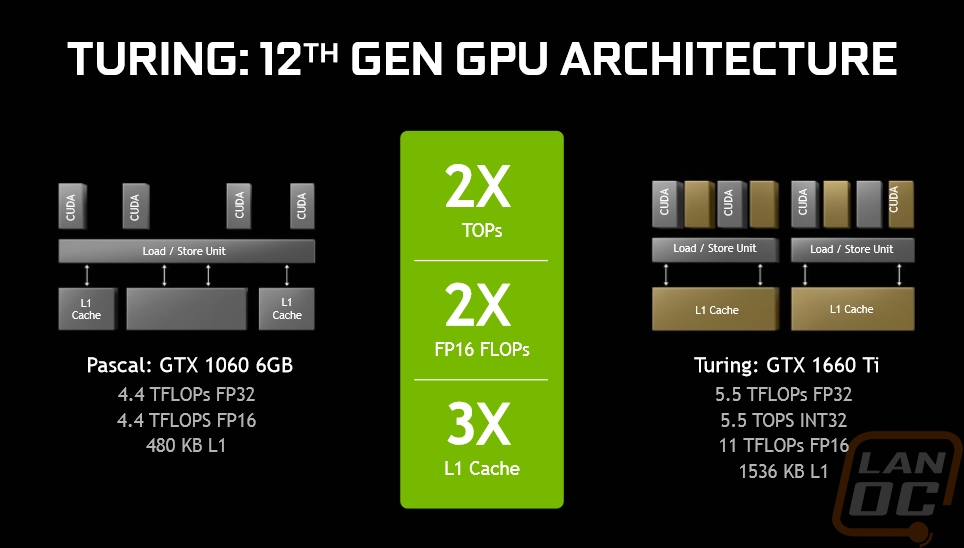
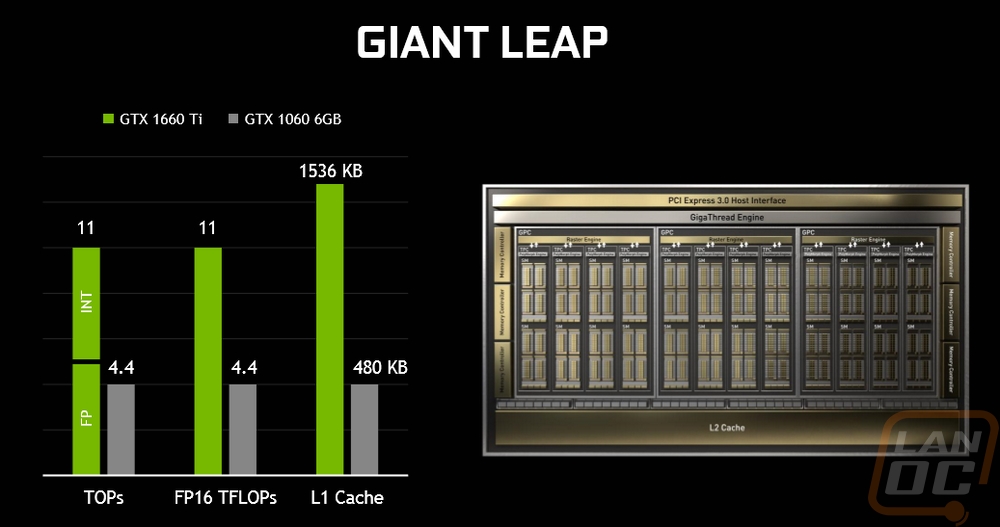 So let's take a look at the specifications and for reference in where the GTX 1660 Ti fits in with everything I have both the GTX 1060 and the RTX 2060 here as well. For starters, officially the GTX 1660 Ti does have a new GPU designation, the TU116. It has 6 fewer SMs than the RTX 2060. With that, the number of CUDA cores for the 1660 Ti is 1536 which is 256 more than the GTX 1060 but also 384 less than the RTX 2060. Interestingly though the GTX 1660 Ti has a much higher base clock and boost clock, similar to the clock speed on the GTX 1060. The GTX 1660 Ti’s memory is running at 12 Gbps which is a little lower than the other Turning GPUs but still faster than any of the Pascal GPUs, especially the GTX 1060 which launched with 8 Gbps memory and later saw a new version with 9 Gbps memory that I think a lot of people forget about. The memory interface is still the same across all three with the 192-bit interface and at least right now the GTX 1660 is available with 6Gb of memory just like the RTX 2060. The GTX 1060 did have a 3GB model as well. Speaking of the memory, it is now GDDR6 not the GDDR5 of the GTX 1060. Dropping the RT and Tensor cores helped with the TDP a lot, as did lowering the number of SMs. The GTX 1660 Ti has a TDP of 120 watts, matching the same TDP on the GTX 1060.
So let's take a look at the specifications and for reference in where the GTX 1660 Ti fits in with everything I have both the GTX 1060 and the RTX 2060 here as well. For starters, officially the GTX 1660 Ti does have a new GPU designation, the TU116. It has 6 fewer SMs than the RTX 2060. With that, the number of CUDA cores for the 1660 Ti is 1536 which is 256 more than the GTX 1060 but also 384 less than the RTX 2060. Interestingly though the GTX 1660 Ti has a much higher base clock and boost clock, similar to the clock speed on the GTX 1060. The GTX 1660 Ti’s memory is running at 12 Gbps which is a little lower than the other Turning GPUs but still faster than any of the Pascal GPUs, especially the GTX 1060 which launched with 8 Gbps memory and later saw a new version with 9 Gbps memory that I think a lot of people forget about. The memory interface is still the same across all three with the 192-bit interface and at least right now the GTX 1660 is available with 6Gb of memory just like the RTX 2060. The GTX 1060 did have a 3GB model as well. Speaking of the memory, it is now GDDR6 not the GDDR5 of the GTX 1060. Dropping the RT and Tensor cores helped with the TDP a lot, as did lowering the number of SMs. The GTX 1660 Ti has a TDP of 120 watts, matching the same TDP on the GTX 1060.
Then we have pricing and if you read the specs above this you already know. The GTX 1660 Ti is launching at $279. The RTX 2060 comes in at $349. Then the GTX 1060 launched at $199 and surprisingly enough, after all, fo the mining craziness it is back down to that same price. So some will be disappointed that the GTX 1060 replacement is now $80 more. That is more than just a bump for inflation, but we will have to wait to see the performance to get a real idea of if the GTX 1660 Ti is a good value or not.
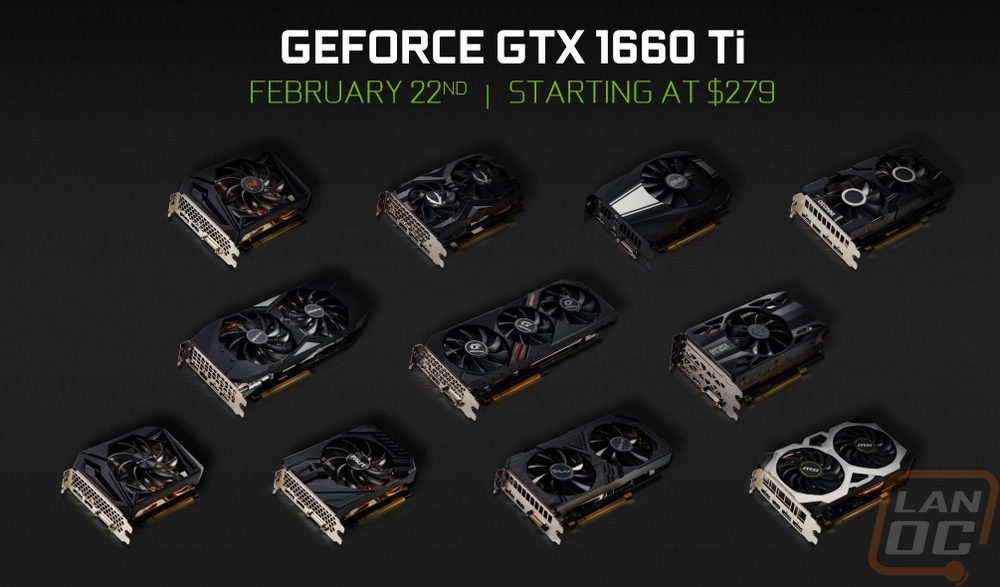
Speaking of, I should mention the card I am testing. Unlike all of the RTX launches this launch doesn’t have a Founders Edition card. So clock speeds, for example, are only a suggestion. Even at the opening price point of $279 it is possible to see overclocked cards. The MSI GTX 1660 Ti Ventus XS that I am testing is an overclocked card. It has a boost clock of 1830 MHz listed which is a bump over the 1770 MHz listed in the GTX 1660 Ti specifications. I would normally confirm with GPUz that the specifications match but I can’t, not to mention GPUz had a bug that wouldn’t show our boost clock speed. So I double checked with the Nvidia Control Panel that we are getting 1830 MHz and as you can see we have the 418.91 driver and while it says standard, this is the pre-launch driver.
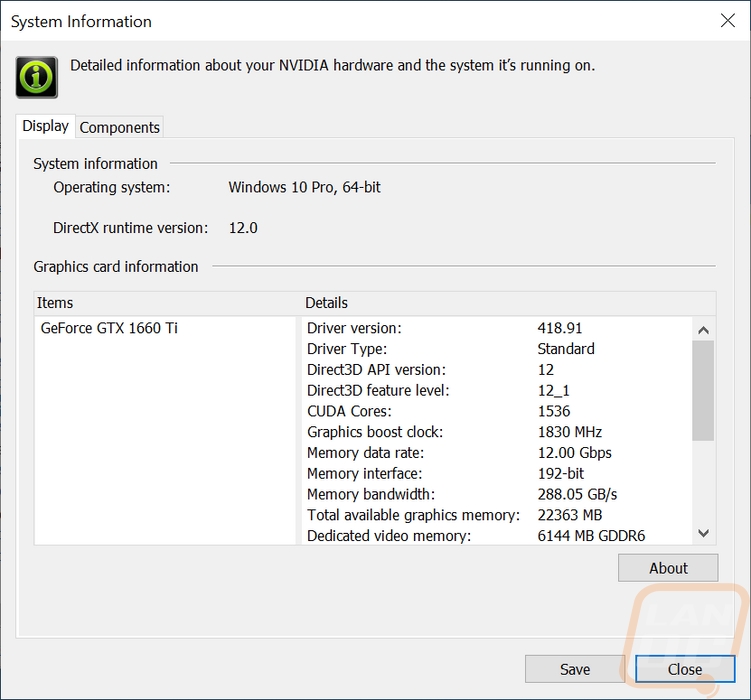
Packaging
The box for the GTX 1660 Ti Ventus XS is exactly what I like to see. MSI has a picture of the card right in the middle on the front of the box. Beyond that, they have the model name, their branding, and of course, that bright green wrap around that goes from the front all the way to the back with info Nvidia requires to be on the box. The background of the box is all black, simple exactly what you need to know and nothing else. Around on the back, the black continues. There is a basic specification listing back here but only with basic GTX 1660 Ti info, not the clock speeds for example. Beyond that MSI has highlighted two main features, their Torx Fan 2.0 design and they talk about the backplate that the Ventus uses.


Inside the box the card come wrapped up in a static protective bag and then it sits in a foam tray cut to the shape of the video card. There is also a sheet of foam that comes on top protecting it from every direction. There aren’t any accessories or even a driver/software disc but you get a basic user guide and a registration card with info on how to register your new card.


Card Layout and Photos
With that completely blacked out box I would have almost expected the same from the card but actually the MSI GTX 1660 Ti Ventus XS is a nice mix of black and a lighter silver. A lot of companies have been going with black and a dark grey which is nice, but this silver used as a trim, not for the whole card like Nvidia’s Founders Edition cards is a nice touch actually. Like the RTX 2060 from MSI that I recently reviewed, the Ventus XS has a dual fan design with two very large fans in an axial configuration meaning they blow down into the heatsink. They both have MSI logos on them and an interesting green ring on the center cap as well. The fans themselves have a high number of fan blades (15 to be exact) and there aren’t any weird tabs on them but they do have a glossy section on every other fan in the same way our last MSI card had a tab on every other blade. The silver accent around the fans reminds me a lot of Nvidia’s older 1000 series Founders Edition cards with their angular look. I should also point out that the cards proportions are off compared to most other cards. It is exactly 8 inches long which is short, but sadly not short enough to be considered an ITX card because those are normally about an inch shorter and match or are at least very close to the length of an ITX motherboard. But then also because of the large fans, this card is tall, you can see that it is just a little under an inch taller than the top of the PCI bracket which normal height is just a touch over that. So the Ventus XS is tall and skinny (mostly), exactly the opposite of my personal frame.


Taking a look at the three thin edges of the card, mostly the top and bottom you can start to get a better idea of the cooling configuration as well. Now, this is my first experience with the GTX 1660 Ti and it might be a cool running card. But I’m not particularly a big fan of the cast machined aluminum heatsinks like this. I prefer a nice standard heatsink with layers of sheet metal for more exposed surface area and this doesn’t really have that. I will find out later how the performance is, but I can tell you for sure that it could be better. Anyhow MSI did use a heatpipe that runs right over the GPU, and snakes up and down to spread the heat out across the heatsink. The two fans then blow down over the heatsink and the hot air is directed up and down with the fin orientation so the warm air will go out those two directions. I wouldn’t put an M.2 under a card with that configuration. The end of the card has surprisingly nothing to offer with that shroud going over it, but I will talk more about that in a minute.



One of the most interesting aspects of the GTX 1660 Ti Ventus XS is this backplate design. I say interesting, but I think for some it will be a pro and others a big con. MSI did something I haven’t seen before and went with a plastic shroud. This is obviously cheaper than a nice heavy duty metal cover, but like with PC cases where the only way to get interesting styling is to use some plastic, they were able to wrap around the end all in one piece cheaply. It could be done with a thick machined piece, Nvidia even did it with their thick casted shroud on the RTX Founders Edition cards. But both options are expensive. The backplate also has the MSI logo and a few stylized lines printed on it as well as a brushed finish cut into it that has a nice feel to it. The plastic is thick, much like the metal Founders Edition designs and the end has vents in it. Now the reason I think this is controversial is because it actually looks really good. But for cooling, plastic is an insulator. Backplates already sometimes contribute to worse cooling, I am considered what plastic will do. So love it or hate it, but I bet you have an opinion on MSIs decision here.


Well the Ventus XS has exactly zero RGB lights which a lot of people will be happy about. That means on the top edge there wasn’t a backlit logo to talk and complain about. MSI went with a much simpler silver painted MSI logo and the GeForce GTX branding which I don’t mind. Also on the top edge was the power connection. I figured with the GTX 1660 Ti’s 120-watt TDP that MSI might actually use a 6 pin like some of the GTX 1060’s use but they stuck with the 8-pin power connection. It is flipped around with the clip on the PCB side with a notch, this orientation allows more heatsink room, but as you can see the heatsink doesn’t go up into this area at all, it is actually not near the top of bottom of the fan shroud.

The end of the Ventus XS has a surprisingly open airflow PCI bracket, especially for a card that isn’t a blower design. Anyhow MSI stuck basically with the same configuration I saw on our RTX 2060 Gaming Z review. That is three DisplayPort connection and one HDMI in between the triplets. This is great on a high-end card but as I mentioned in the 2060 review, you start to reach a point in the lineup where the chance of someone still needing those legacy connections for older monitors comes around and I think we are at that point. A DVI connection would have been much better than a third DisplayPort in my opinion. I would also love for that bracket to be tinted or even better, all black. A majority of cases today are black and a nice black PCI bracket makes a surprisingly big difference.

Test Rig and Procedures
Our Test Rig Configuration (with affiliate links)
CPU - Intel i9-7960X
Motherboard - Asus ROG Rampage VI Apex
Memory - HyperX DDR4 Predator 3000MHz
Storage - Kingston A1000 960GB M.2 SSD
Cooling - Noctua NH-U12S
Power Supply - Corsair AX1200w
Case - Primochill Wetbench

Synthetic Benchmarks
To start off testing, I like to run through a few different synthetic benchmarks. They give us a nice consistent way to compare from card to card and in this case, we can see where the GTX 1660 Ti fits into the market and also see how it compares with the GTX 1060 and the RTX 2060. I’m also very curious how the AMD RX590 compares as well. A lot of my testing is done in 3DMark and I started off with the three DX111 based Fire Strike benchmarks. Fire Strike can be run at three detail levels, performance, extreme, and ultra. At the performance detail setting the GTX 1660 Ti came in right in between the RX580 and the RX590 and WELL above the GTX 1060 that it is replacing. In Fire Strike Extreme the result was similar, the RX590 wasn’t far behind but the 7529 score was well above the original GTX 1060. The gap here between the RTX 2060 and the GTX 1660 Ti is a large one as well. In the Fire Strike Ultra test, both the AMD RX590 and RX580 pulled ahead of the GTX 1660 Ti at this detail level.



Now the Turing based RTX cards have favored the DX12 based Time Spy tests a lot more and the result is the same again here, even without the Tensor and RT cores. In the original Time Spy the GTX 1660 Ti ended up above the GTX 1070 and had a huge 53% increase over the GTX 1060. In the Time Spy Extreme test, the result was similar only with a 50% increase this time.


I didn’t only test with 3DMark based tests. I did also test using the Unigine based Superposition benchmark as well. Here I tested twice at 1080p with two wildly different detail levels. Then again at 4k and 8k to take a look at the ultra-high resolutions. In the 1080p Medium test the GTX 1660 Ti was battling with the GTX 1070 coming in just below it. The RX590 and RX580, as well as the GTX 1060, were down 2-3k points below. This was repeated across all of the other tests as well.

VR Benchmarks
The number of VR benchmarks that can anyone can run without a headset is a little limited and I like to keep all of our tests as repeatable by you, the reader. But we do have two benchmarks that I like to run. The SteamVR benchmark is a little dated with nearly every card maxing it out these days but surprisingly the GTX 1660 Ti falls just under the top score of 11 with a 10.8. This shows us that it is just behind the stock clocked GTX 1070 FE and way ahead of the RX590 and GTX 1060.
In my second set of VR tests, we have VRMark. This has three different tests with each called a room. The orange room test is the original benchmark and this is a lot like SteamVR in that it is only looking at basic VR performance. Here the GTX 1660 Ti saw 214.93 FPS which is well over the 109 FPS that all three tests require. In the Cyan Room test, the 135.18 FPS result is closer to the limit but still over what is needed. That test looks to test performance similar to today's demanding VR games so this tells us that the GTX 1660 Ti would do well in just about anything VR we throw at it right now. Then the last test is the Blue Room test which is future looking at high detail games in the future and here it only did 43.09 FPS and was far from the 109 FPS goal, just like every other card tested. Performance was up above the GTX 1070 in all three results though, this put the GTX 1660 Ti also above the RX590, RX580, and GTX 1060.


In-Game Benchmarks
Now we finally get into the in game performance and that is the main reason people pick up a new video card. To test things out I ran through our new benchmark suite that tests 12 games at three different resolutions (1080p, 1440p, and 4k). I also slipped in a few variations on the same games for comparisons like DX11 to DX12, OpenGL to Vulkan, and a couple of games are just tested at their highest setting and lower but still high detail options to show the performance difference when things are turned down slightly. In total, each video card is tested 54 times and that makes for a huge mess of graphs when you put them all together. To help with that I like to start off with these overall playability graphs that take all of the results and give an easier to read the result. I have one for each of the three resolutions and each is broken up into four FPS ranges. Under 30 FPS is considered unplayable, over 30 is playable but not ideal, over 60 is the sweet spot, and then over 120 FPS is for high refresh rate monitors. This covers all of the games tested except Final Fantasy XV that we have a score rather than an FPS because they like to be different.
So how did the MSI GTX 1660 Ti Ventus XS perform? Well at 1080p three of our tests were over 120 FPS, 12 were over 60, and two fell into the playable but not smooth 30-60 range. In other words, all of our tests, even at their highest detail settings were playable with most performing great at 1080p. At 1440p two were still playable at 120 FPS, 9 at 60 this time, and now 6 are in that 30-60 FPS range. So turning the resolution up on the GTX 1660 Ti starts to show some performance issues with a lot more in that 30-60 range that is playable but you will want to adjust the settings up for smooth gameplay. Then at 4k things tripped and fell on their face. Only 2 games are above 60 FPS, 9 are in the 30-60 range, and 6 were unplayable at all under 30 FPS. Basically what this is telling us is the GTX 1660 Ti is a great card for 1080p, you can expect it to play anything smoothly at that resolution with some of the less demanding games like the “esports” titles playing in the 120 FPS or higher range. 1440p can work but you will have to turn things down and just don’t game at 4k.



But let's take a closer look at the charts to see how the GTX 1660 Ti compares to the other cards and to see if there were any interesting results. Now I normally sort all of our results by the 4k setting, but for this card, I did them by 1080p, so there are a few games like Warhammer where 4k and 1440p performance wasn’t great but it played great at 1080p and the GTX 1660 Ti looks a little artificially high in the charts. Keep that in mind. Overall what I found was Nvidia’s new card actually runs with and in most cases outperforms the GTX 1070 FE. It doesn’t outperform the GTX 1070 Ti like the RTX 2060 does, but running with the GTX 1070 is a significant improvement over the GTX 1060 and is well above the RX590 as well.


















Compute Benchmarks
Not everyone uses their PC for gaming or in some cases people like to game and work with the same PC. Because of that, I did run through a few different compute tasks to get an idea of how the GTX 1660 Ti performs in these. The first was a simple synthetic benchmark with the Passmark Performance Test 9’s GPU Compute test. Here you can see a big gap between the GTX 1660 Ti and the RTX 2060, but it did outperform the RX590/580 and the GTX 1060.

Blender is one of the most popular 3D rending programs and it is free and open source. The default benchmark does have issues with RTX cards so I have updated our benchmark with the mid-January build which supports the new cards and lets us get a full look at how all of today's cards run in Blender. The GTX 1660 Ti doesn’t have the tensor and rt cores but it still did very well here, outperforming the GTX 1070 Ti and GTX 1080 FE but coming in behind the RTX cards and the GTX 1080 Ti.

For another synthetic benchmark, I used Basemarks GPU test using both DirectX 12 and OpenGL, the GTX 1660 Ti outperformed the GTX 1060 here, especially in Open GL.

My last test was Geekbench 4’s GPU compute test using OpenCL. The gap here between the GTX 1060 and GTX 1660 Ti is significant, but you can also see there is a good sized margin between the RTX 2060 and it as well.

Cooling, Noise, and Power
My last round of testing is always focused on none gaming or work focused aspects. This includes power usage, but is mostly focused on the performance of the cooler with both noise and temperature testing. This is also where different brands and models of cards most significantly set themselves apart from other cards with the same GPU model. My first tests were focused on the power usage of the GTX 1660 Ti. Here I tested twice using our Kill-A-Watt the power drawn for our test system. Once I loaded everything up with 3DMark Fire Strike using its combined benchmark to put a game like load on the GPU and the CPU. In this test, the GTX 1660 Ti pulled 297 watts which were a touch below the GTX 1070 that it outperformed in most tests. Interestingly this was over 40 watts higher than the GTX 1060 FE which has the same TDP. In my second test, I loaded up the GPU harder with AIDA64’s stress test. This result is lower because the CPU isn’t also loaded. At 215 watts the gap between the GTX 1060 and GTX 1660 Ti is smaller here.


The noise testing is our first real look at the GTX 1660 Ti Ventus XS’s cooler. With the fans cranked up to 100% I tested the noise level to get an idea of how loud the card is capable of being. The two fans didn’t do to bad here actually at 53.8 decibels. 40% fan speed was much better at 35 decibels, in fact, that was the quietest card at 50% fan speed tested. The RPM graph shows partially why the Ventus XS was quiet, MSI doesn’t have the cards two fans running at that high of a speed when cranked up.


Now cooling performance, I was especially interested in this after bashing on the heatsink design of the Ventus XS. I ran two tests here as well, one with the stock fan profile and then again with the fans at 100%. This lets us know what you can expect out of the box and then when the cooler is capable overall. With the stock fan profile, the Ventus XS ran under load at 59 degrees which isn’t too bad at all. This was in line with the various aftermarket RTX 2060’s I have tested. Cranking the fan speed up however you can see it move into the middle of the chart at 52 degrees. There is still some headroom, but not a large margin. Enough to get the job done and I wouldn’t consider this a hot card at all, but it will be interesting to see how this compares to other GTX 1660 Ti’s later.


While doing the stock fan setting testing I did also get a few thermal pictures of the Ventus XS. On the fan side, I did notice that where the heatsink ends short of the bottom of the PCB things are especially warm down in that area, sat with near the top where again the heatsink stops short. You can especially see it from the top down view. Now the back picture does a good job of showing what I was concerned about with the plastic backplate. There is some heat coming through but overall you can see how it is insulating and keeping heat in, notice how much warmer it is in the screw holes.

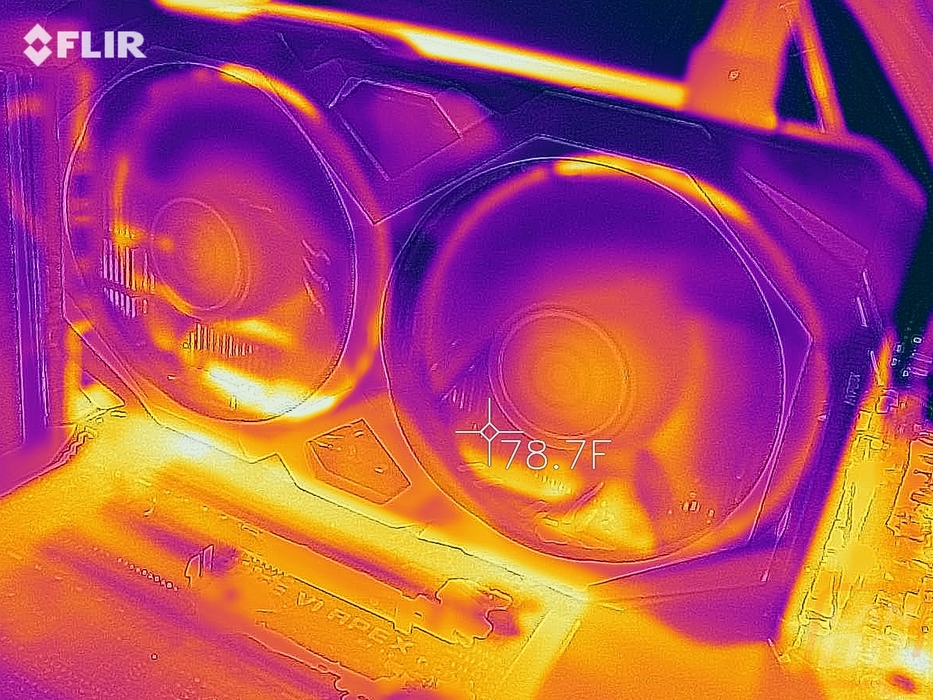
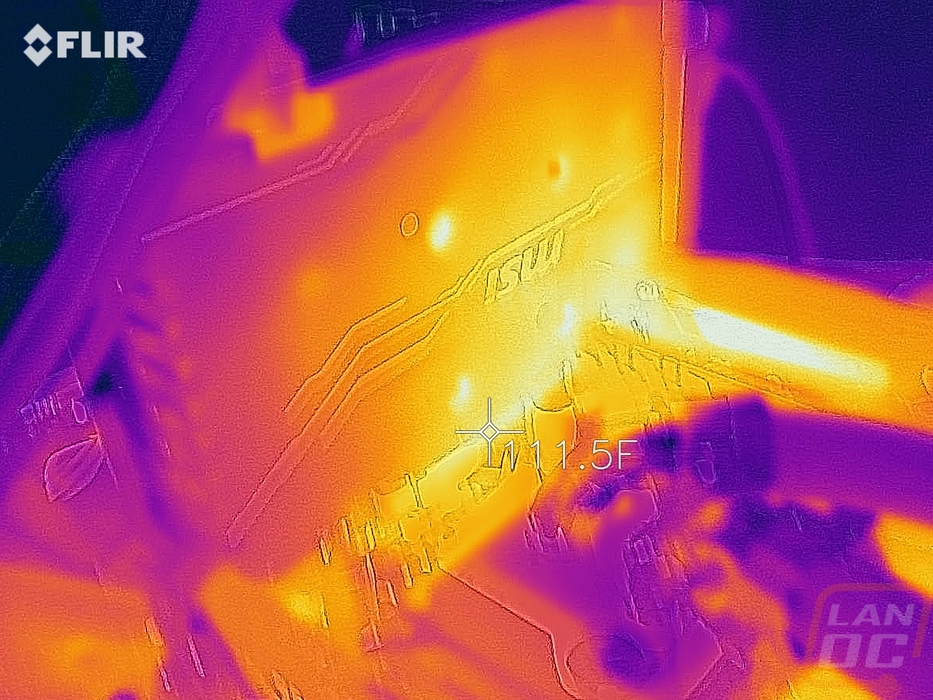
Overall and Final Verdict
Well, the testing is done, we have gone over what the hell a GTX 1660 Ti is, and I took a look at the MSI GTX 1660 Ti Ventus XS.. All that is left to do is run through a few of the key points and see where this fits in the market both in pricing and performance. As far as the GTX 1660 Ti goes I may not understand at all the reason for the 1660 over a 2000 series number or 1160. But I was impressed with Nvidia’s new cards performance. It sits solidly as a 1080p card that is going to handle any games you throw at it at their highest settings at 1080p. More importantly, it stomped the original GTX 1060 and along with that the RX580/590 as well. I really wish I had a Vega 56 to compare it with. But I was impressed with it outperforming the GTX 1070 FE in a lot of our testing. The MSI Ventus XS that I tested also impressed in a few areas. I really like the look of this card with the mix of black and the lighter silver for trim and not adding any RGB lighting on this card was a good choice. I don’t mind lighting, but I don’t think every card needs to have it as well.
Now I did have a few complains they were all focused on MSI's card though not the GTX 1660 Ti. Specifically, I have the heatsink listed as a complaint. Normally I would just say bad cooling performance but MSI did size out this cooler right and the card runs at perfectly adequately but only that. They went with a cast heatsink design over a sheet metal design with more surface area and on top of that, the cooler was much smaller than the fans and fan shroud. I will get a chance to compare the cooler to other cards later so it will be interesting how it compares. The inclusion of a plastic backplate was also a little controversial. On one hand, it looks great actually. But thermally backplates don’t really help things even when they are metal. But using plastic which is more of an insulator is concerning.
Overall though I was happy with the performance of the Ventus XS and the GTX 1660 Ti. It set itself well ahead of the GTX 1060, but that is to be expected when we see the $279 launch price right? That is more than the GTX 1060 launched at or is selling at right now. AMD announced their Vega 56 cards are now priced in this same range as well, but a quick look at Newegg shows that this isn’t happening right now when they are selling at twice that. So at least right now the GTX 1660 Ti is alone in this price range. The GTX 1070 which is slower is selling for more, the RX590 is selling for $260 and isn’t even close in performance as well. So while I was really hoping for the GTX 1060 replacement to be a little closer to the GTX 1060 in price, right now for price/performance the GTX 1660 Ti is a good pickup.


Live Pricing: HERE


